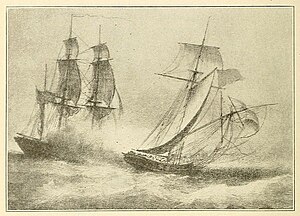Action of 2 March 1825
| Capture of the Anne | |||||||
|---|---|---|---|---|---|---|---|
| Part of West Indies Anti-Piracy Operations, Piracy in the Caribbean | |||||||
 Una Goleta de Guerra Persigue un Barco Pirata, the artwork used to depict the event in Paul G. Miller's Historia de Puerto Rico (1922). |
|||||||
|
|||||||
| Belligerents | |||||||
|
|
Roberto Cofresí's Pirates | ||||||
| Commanders and leaders | |||||||
|
John D. Sloat Tomás Renovales Garrett J. Pendergrast Juan Bautista Pierety Salvador Pastoriza |
Roberto Cofresí | ||||||
| Strength | |||||||
|
United States: 1 schooner 140 sailors and marine infantry Spain/Denmark: 3 sloops sailors and marine infantry Support: 1 frigate sailors and marine infantry |
3 sloops 1 schooner At least a dozen armed pirates on the flagship |
||||||
| Casualties and losses | |||||||
| ~2 wounded 1 sloop damaged |
~3 killed 6 wounded 1 sloop captured |
||||||
The Capture of the Anne was the result of a naval campaign carried out by an alliance between the Spanish Empire forces in Puerto Rico, the Danish government in Saint Thomas and the United States Navy that pursued Roberto Cofresí's pirate flotilla in March 1825. The campaign was instigated by economic losses suffered by all of the parties involved due to the pirates' actions, as well as diplomatic concerns caused by their use of the flags of Spain and Gran Colombia which menaced the fragile peace between the naval powers. There were additional personal motivations by several of those involved, who had been directly attacked by the freebooters themselves. Among the diplomatic concerns caused by Cofresí was a robbery carried out by several of his subordinates, which in turn served as the catalyst behind an incident that threatened war between Spain and the United States known as "The Foxardo Affair", eventually leading to the resignation of his rival, pirate hunter David Porter.
Sailing under the authorization of the Danish West Indies, the coalition employed two local ships, including a former victim of the pirates named San José y las Animas, and the USS Grampus of the West Indies Squadron. A ship from Gran Colombia, named La Invencible, also provided support during the initial stages. The final naval engagement took place on March 2, 1825, and began with a trap set at Boca del Infierno, a passage off Jobos Bay, Puerto Rico. The flagship of Cofresí's flotilla, the sloop Anne (otherwise known as Ana or El Mosquito), was baited by the set up. Unable to effectively counter the surprise attack and outnumbered, the pirates abandoned the ship and escaped to shore, where they were later captured by Puerto Rican authorities and placed on military trial. With the subsequent execution of Cofresí, the West Indies Anti-Piracy Operations were considered a success and he came to be known as "the last of the West India pirates".
...
Wikipedia
